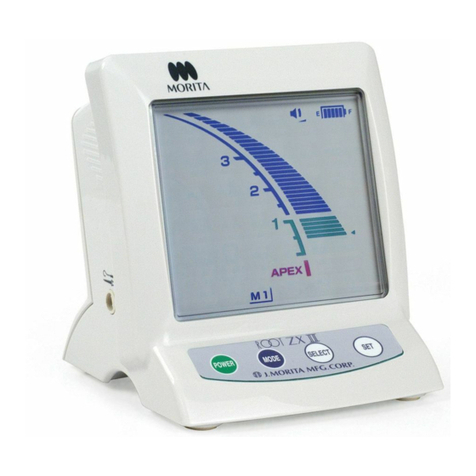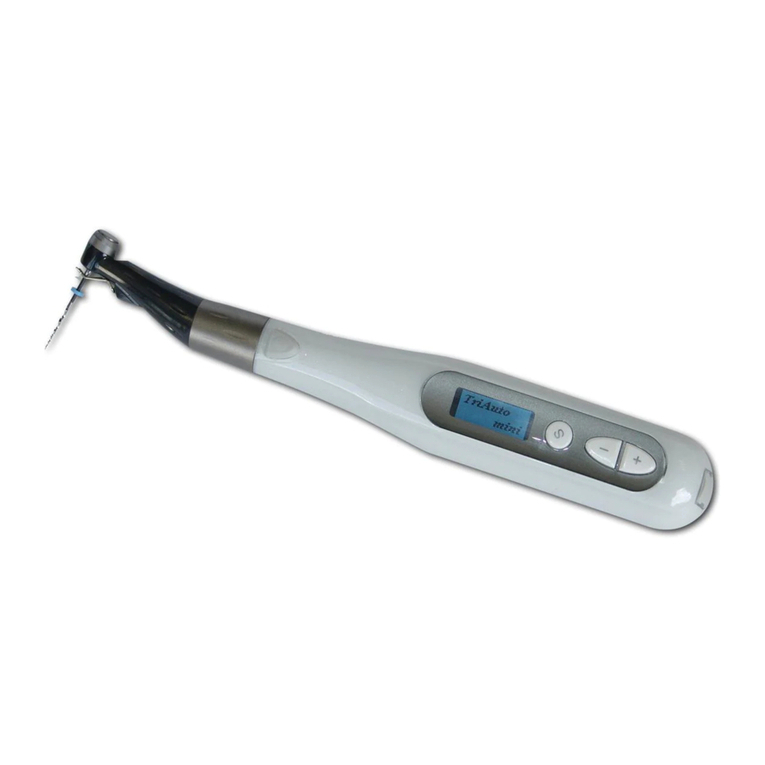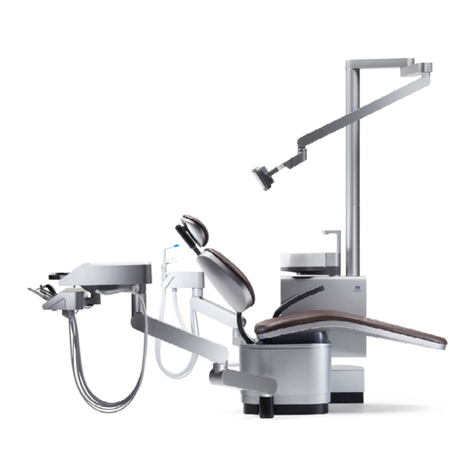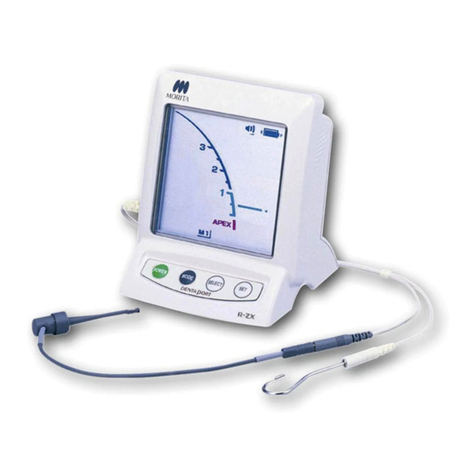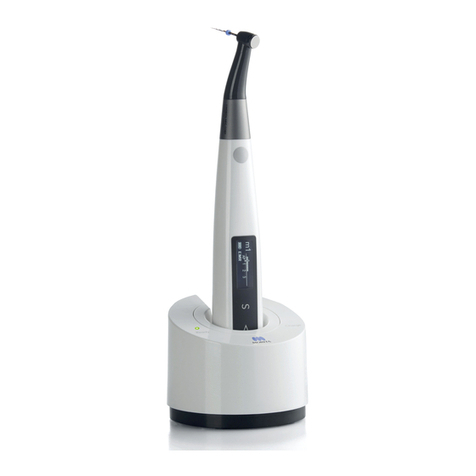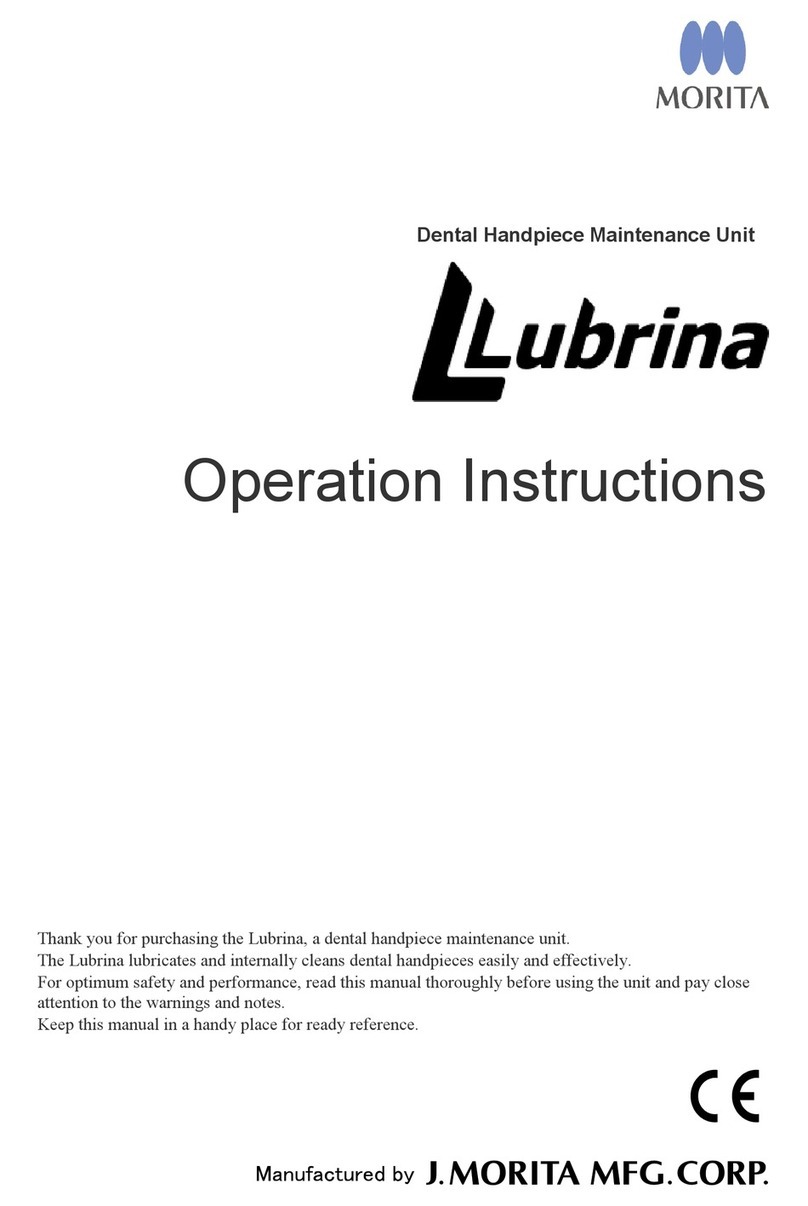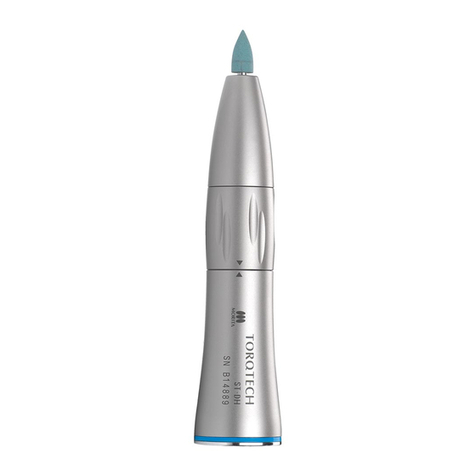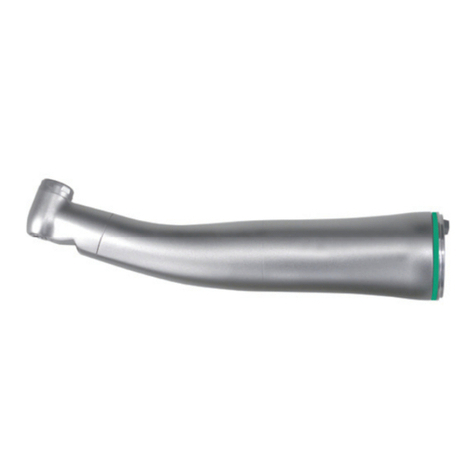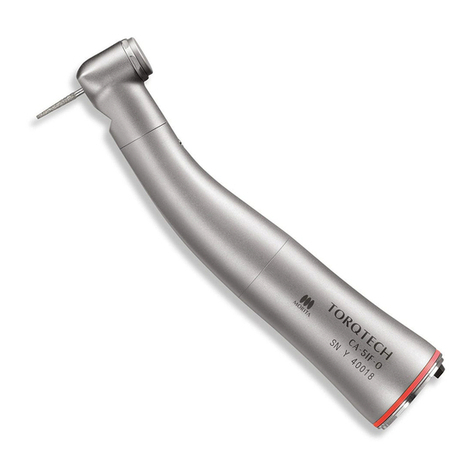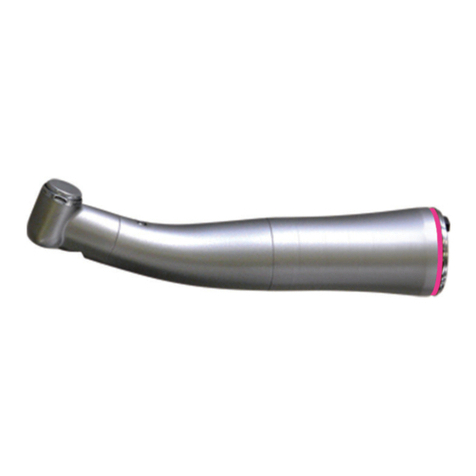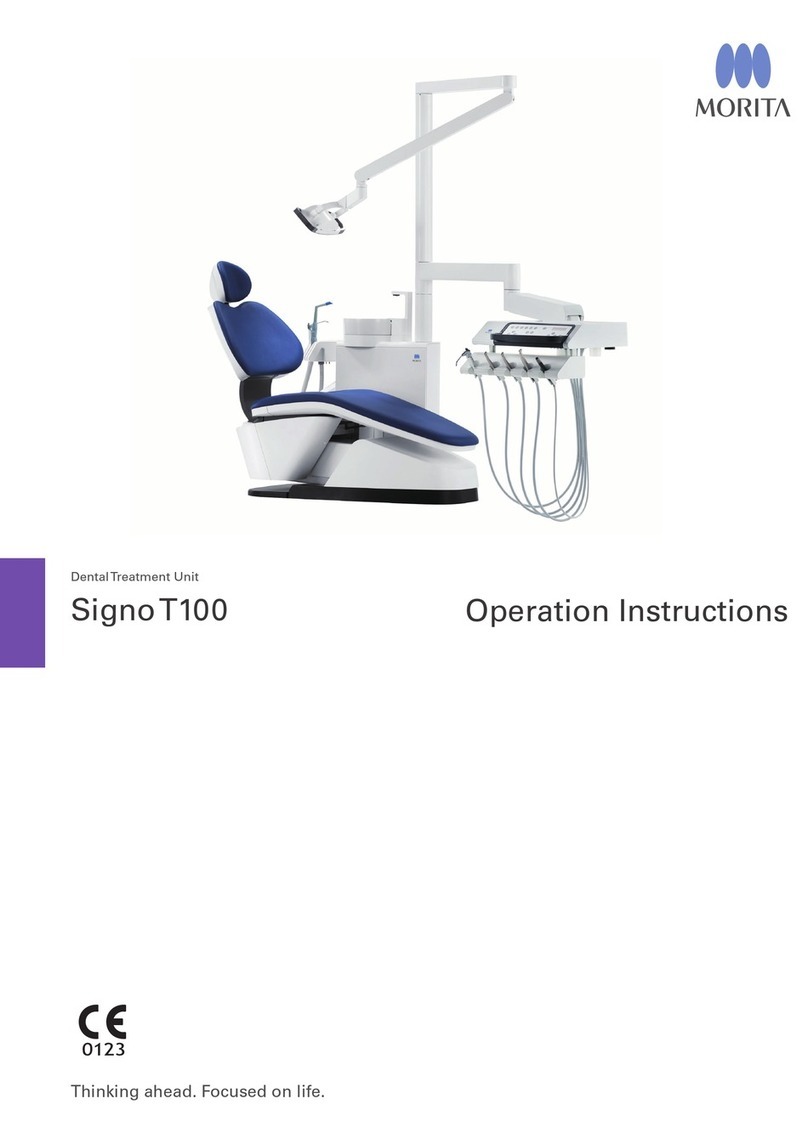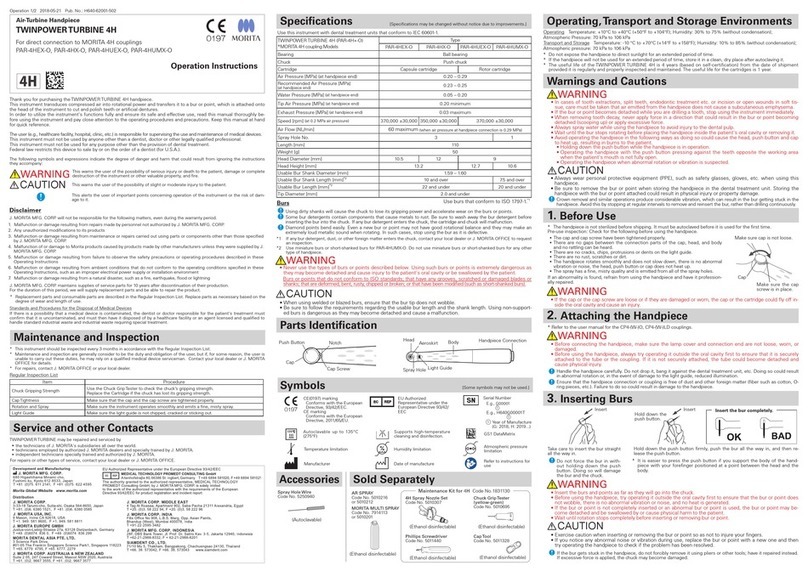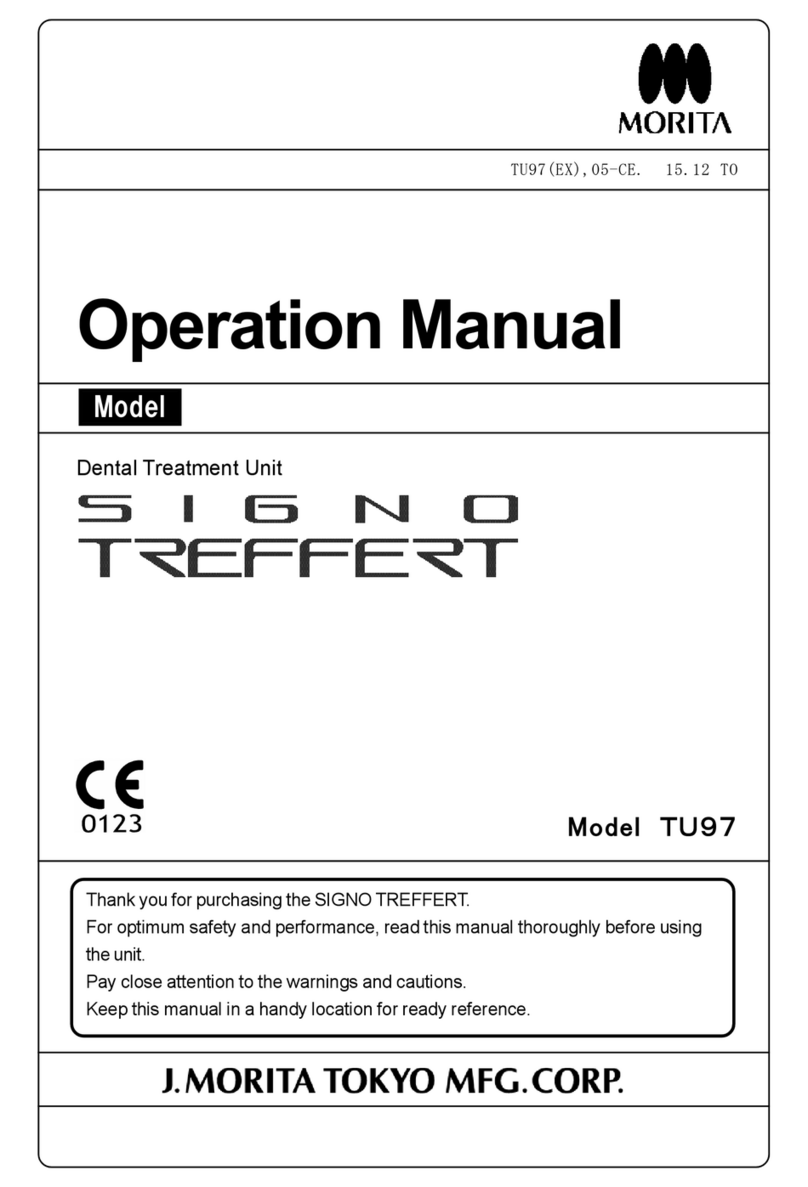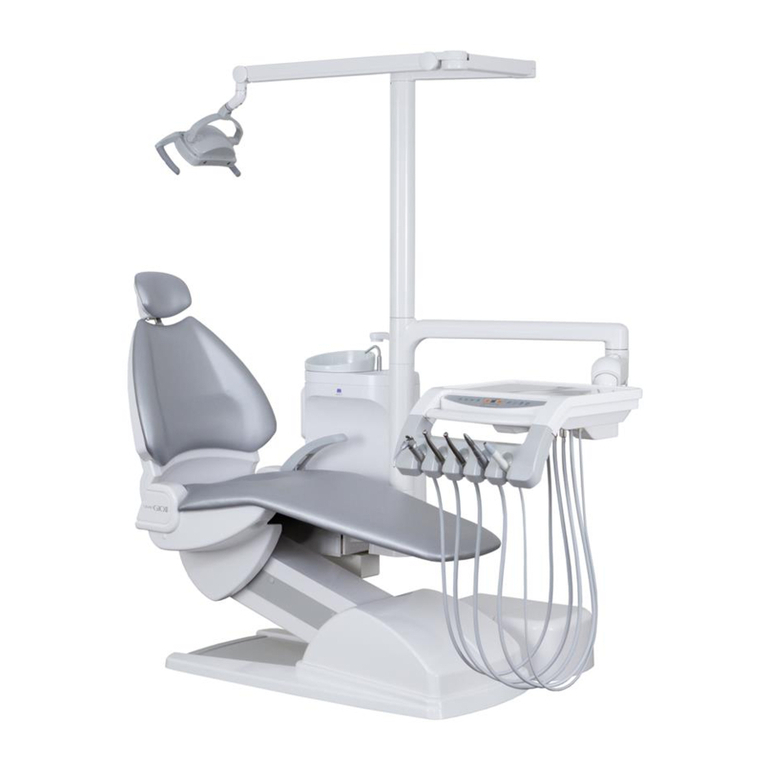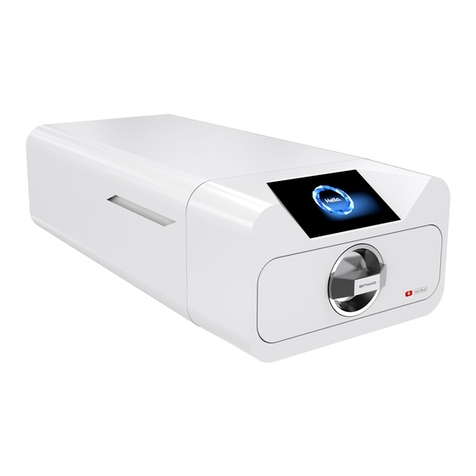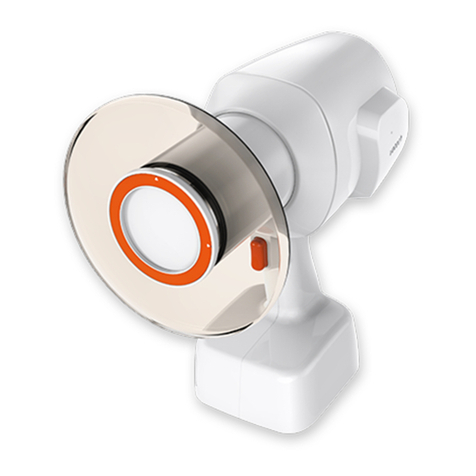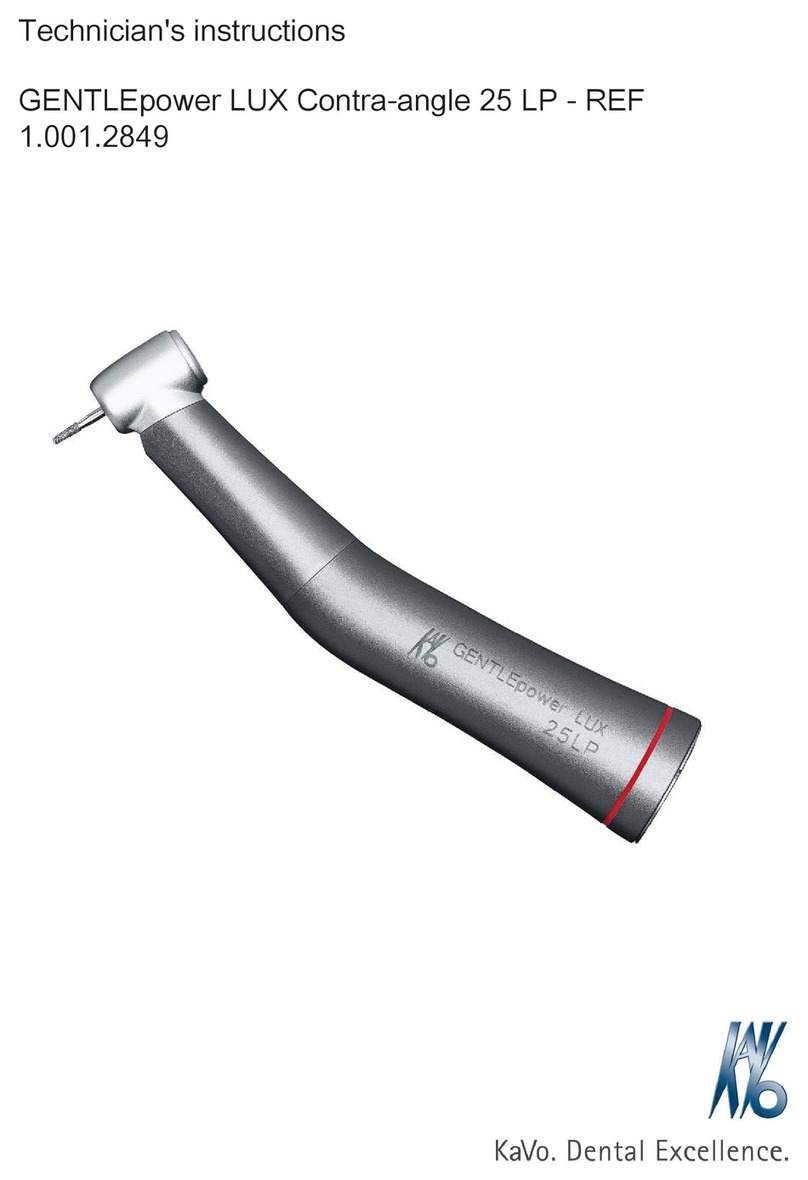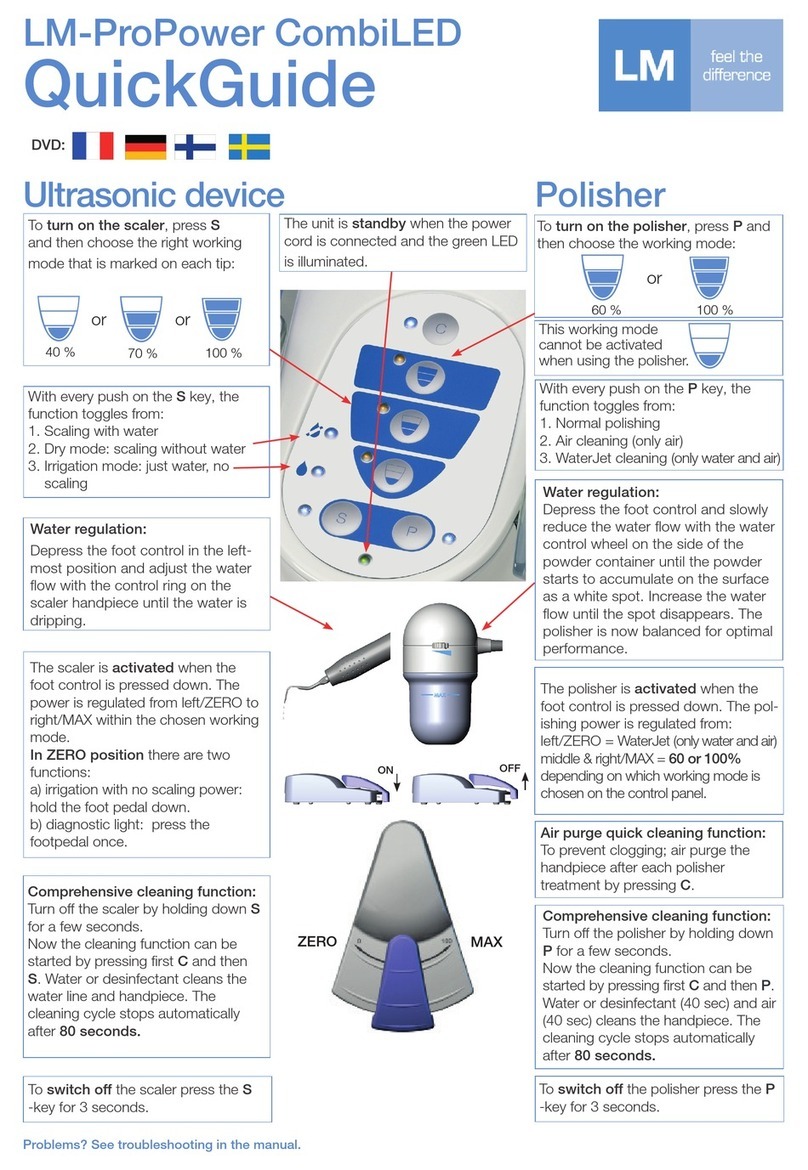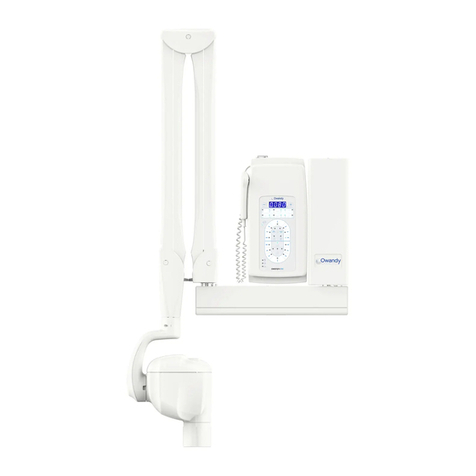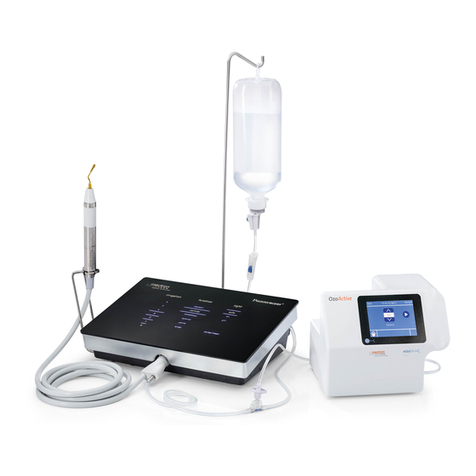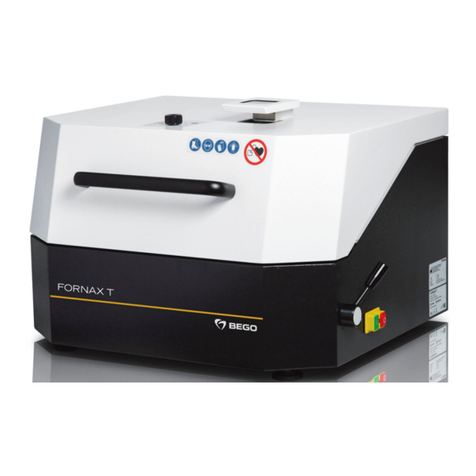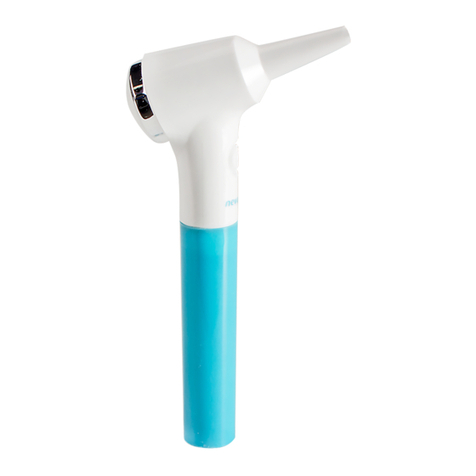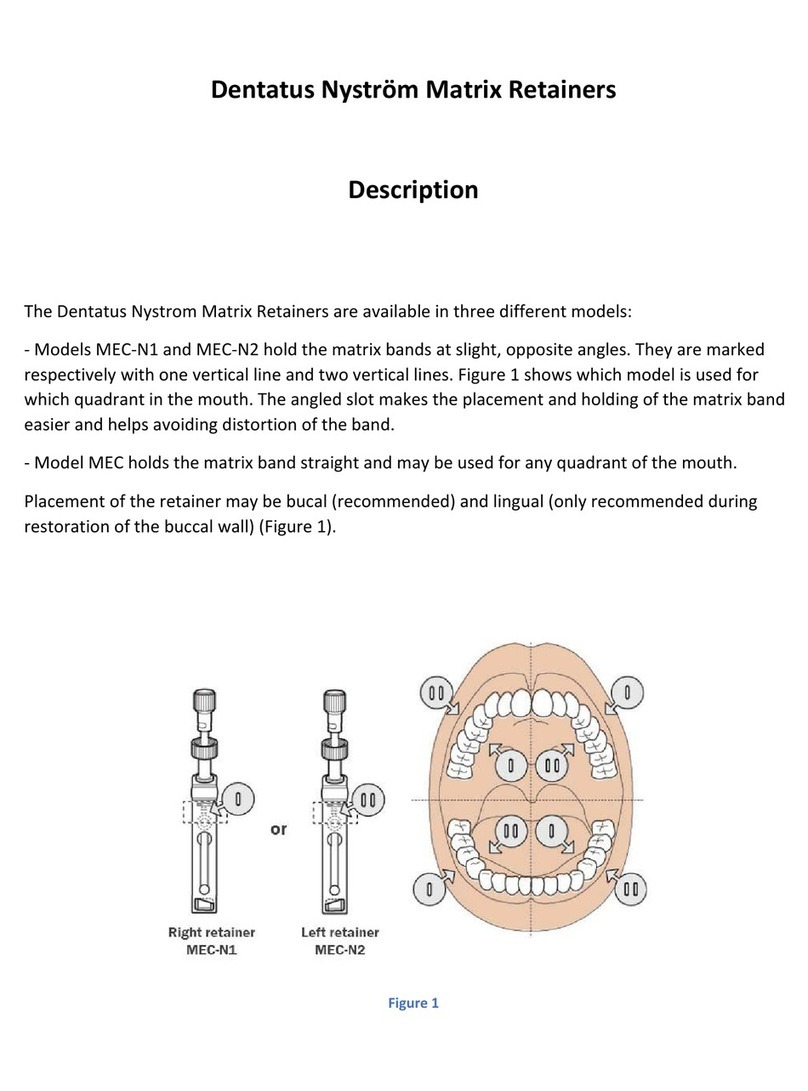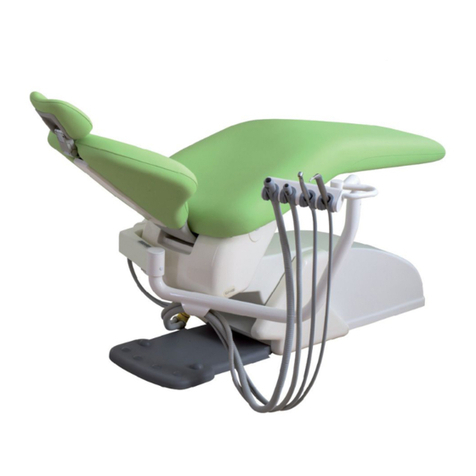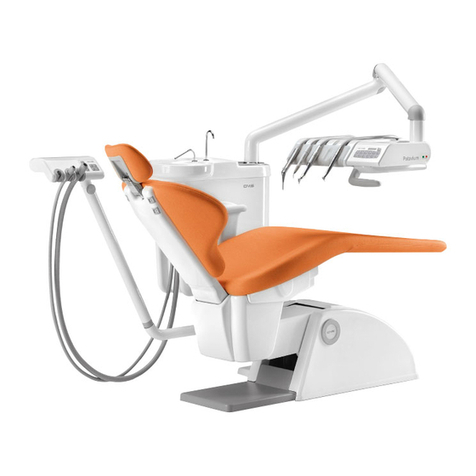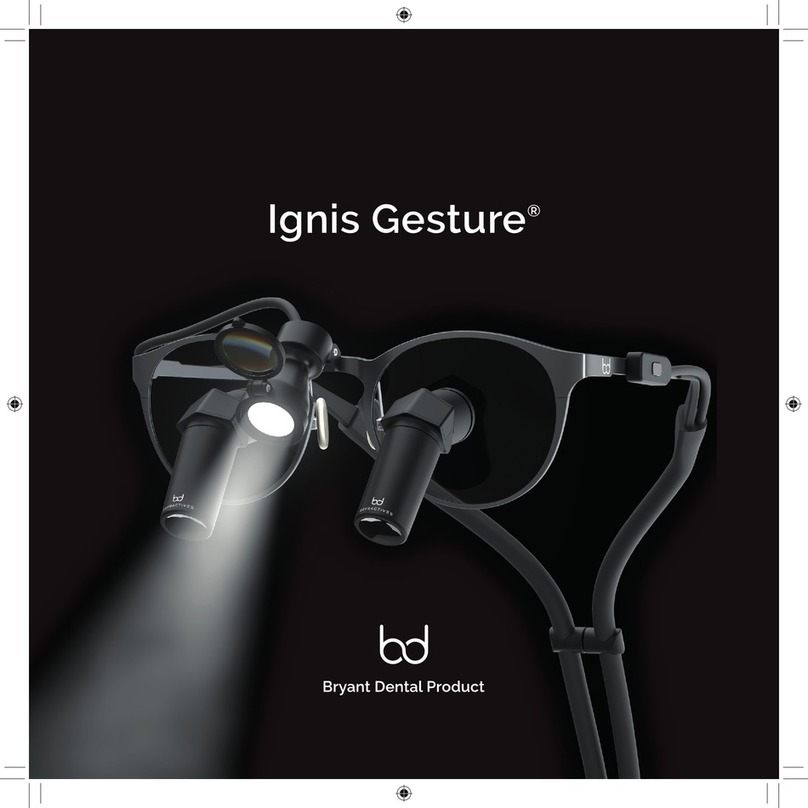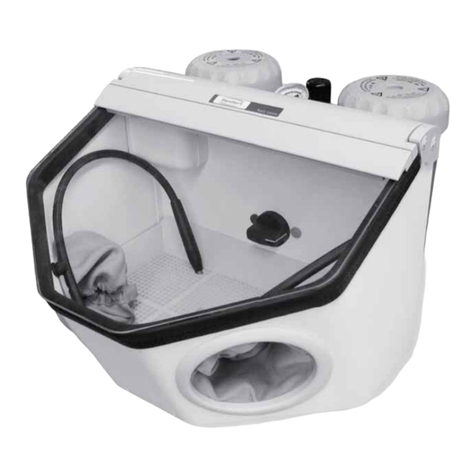
12 Months
< Remove >
< Insert >
• Always insert cups or brushes all the way in and give them a light tug to make sure they will not come out.
Otherwise, a cup or brush could come out and injure the patient or be swallowed.
• Wait for the handpiece to completely stop rotating before inserting or removing a cup or brush.
3. Inserting and Removing Cups and Brushes
• Protect your fingers from being cut by wearing gloves whenever you put in or take out a cup or brush.
Operation 2/2
Take out the cup or brush and disconnect the handpiece from the mo-
tor.
* Refer to the user manual for the motor.
* It may be hard to remove a cup or brush if it is left in the handpiece.
4. After Use
5. Cleaning
Wipe the handpiece with a piece of gauze that has been dampened with
Ethanol for Disinfection (ethanol 70 to 80 vol%) and wrung out thorough-
ly.
6. Disinfection
10. Troubleshooting
◆Cup or Brush will not go in chuck.
Make sure the motor is properly connected to its tube. Remove the handpiece from the motor and step on the foot
control. Does the motor run?
If motor runs
Connect the handpiece securely to the motor and step on the foot control to see if the cup or brush rotates. If it
does not have the handpiece repaired.
If the motor does not run
Refer to the accompany user manual for the motor.
◆Cup or Brush does not rotate.
Lubricate the handpiece, and then use a new cup or brush to check if the problem has been resolved.
If this does not solve the problem, have the handpiece repaired.
Before inspecting or adjusting the handpiece, make sure the main power switch is turned on and that the main air and
water valves are open. If the handpiece does not work properly even after inspection and adjustment, contact your local
dealer or J. MORITA OFFICE and have it repaired.
TERMS AND CONDITIONS
J. MORITA MFG. CORP. warrants the Product as follows:
1. Warranty Term.
J. MORITA MFG. CORP. warrants that the Product will be free from defects in materials and workmanship for 12 months.
2. Items Not Covered by Warranty.
This Warranty will not cover parts of the Product or consumables which normally need to be replaced such as glass or rubber components,
and the like. Further, this warranty will not cover defects or damage caused by:
a. Failure to operate or use the Product in accordance with the Operation Instructions or warning/cautionary labels.
b. Modifications of the Product, connecting the Product to other products, or using components or replacement parts not specified
or approved by J. MORITA MFG. CORP.
c. Repairs performed by parties not designated by J. MORITA MFG. CORP.
d. Accidents or forces outside of J. MORITA MFG. CORP.’s control, such as dropping the Product or collision of the Product with
other objects, fire, flood, natural disaster, etc.
e. Use or operation of the Product in settings or under conditions not specified by J. MORITA MFG. CORP. or set forth in the
Operation Instructions including, without limitation, unauthorized changes in equipment settings, connection to unauthorized
devices.
3. Remedies of Customer.
Customer must present this Warranty when claiming coverage or application thereof, and either ship or deliver the Product to an
authorized location of J. MORITA MFG. CORP. or its subsidiaries or authorized dealers. Upon receipt and verification of this Warranty,
inspection of the Product, and determination of coverage by this Warranty, J. MORITA MFG. CORP. will, at its sole option, supply the
parts or components either replaced or repaired free of charge to the Customer. Delivery and shipping charges are the responsibility
of the Customer.
4. LIMITATIONS AND EXCLUSIONS FROM WARRANTY.
The remedy set forth in paragraph 3 is the sole and exclusive remedy of Customer. J. MORITA MFG. CORP. MAKES NO OTHER
EXPRESS OR IMPLIED WARRANTIES AND SPECIFICALLY EXCLUDES ALL OTHER WARRANTIES INCLUDING, WITHOUT LIMITA-
TION, ANY IMPLIED WARRANTIES OF MERCHANTABILITY OR FITNESS FOR A PARTICULAR PURPOSE. IN NO EVENT SHALL J.
MORITA MFG. CORP. BE LIABLE FOR ANY INCIDENTAL OR CONSEQUENTIAL, DIRECT OR INDIRECT, OR SPECIAL DAMAGES
OF ANY KIND INCLUDING, WITHOUT LIMITATION, DAMAGES FOR LOSS OF REVENUE, LOSS OF BUSINESS OR BUSINESS
OPPORTUNITY, OR OTHER SIMILAR FINANCIAL LOSS ARISING OUT OF THE PERFORMANCE, USE OR INTERRUPTED USE OF
THE PRODUCT.
5. Repairs Not Covered by Warranty.
With respect to repairs not within the period of this Warranty or otherwise not covered by this Warranty, J. MORITA MFG. CORP. will
perform the same, timely, efficiently, and for an appropriate cost.
9. Packing and Sterilization
Axle
Screw
Loosen Tighten
Cup or Brush
Make sure that the screw of the cup or brush is not worn
out, corroded, bent or warped.
Grip the cup or brush and unscrew it.
If it is hard to get off, take the handpiece off the motor, and fix the shaft in its joint to the cup support jig provided;
then unscrew the cup or brush.
Grip the cup or brush and insert the threaded part into the rotation
shaft; then lightly screw it all the way on. After screwing it on,
make sure the cup or brush is securely and completely installed.
Shaft
Cup Support Jig
Cup or Brush
Cup Support Jig
2018-05-21 Pub.No.: L115-62001-501
If a medical agent being used for the treatment has adhered to
the handpiece, wash it off in running water.
Do not perform ultra sonic cleaning.
Clean drilling and polishing debris off the head with a brush and
running water.
After cleaning, use the syringe or an air blow gun to get rid of any
moisture left inside the handpiece.
Do not use anything except ethanol. Do not use too much ethanol; it could seep inside and damage the handpiece.
Rotation and spray delivery will be impaired if debris gets inside the water or air lines.
Do not immerse the handpiece in or wipe it with any of the following: functional water (acidic electrolyzed water,
strong alkaline solution, and ozone water), medical agents (glutaral, etc.), or any other special types of water or
commercial cleaning liquids. Such liquids may result in metal corrosion and adhesion of the residual medical agent to
the handpiece.
Unit Name Mode Detergent
(concentration)
Neutralizer*
(concentration)
Rinse
(concentration)
Miele G7881 Vario TD neodisher MediClean
(0.3 – 0.5%)
neodisher Z
(0.1 – 0.2%)
neodisher Mielclear
(0.02 – 0.04%)
* After cleaning there may be streaks or white spots on the instrument.
Use a neutralizer only if there are streaks or white spots.
* When using a high-temperature washer-disinfector to clean the handpiece, strictly adhere to the
conditions specified below.
High-temperature cleaning conditions
Operating conditions for high-temperature washer-disinfectors
Operating Precautions
• Always use a handpiece holder when washing the handpiece, making sure to rinse the inside of the handpiece
thoroughly.
• For details on handling medical agents or adjusting their concentration, refer to the user manual for the washing device.
• After washing is complete, check to see if the handpiece, including its inside, is completely dry. If any water
remains inside the handpiece, expel it with an air gun or another such tool. Failure to do so could result in the
remaining water coming out during use and cause poor lubrication or sterilization.
• Always lubricate the handpiece after washing.
Always use a handpiece holder when washing the handpiece; otherwise any medical agent remains inside the
handpiece, it may corrode or clog the air or water pipe, resulting in a malfunction of the handpiece.
Inappropriate cleaning methods and solutions will damage the handpiece.
Do not clean the handpiece using strong acidic or alkaline solutions that could cause the metal to corrode.
Any moisture left inside the handpiece could result in the remaining water coming out during use and cause
corrosion, or poor lubrication and sterilization.
Do not leave a handpiece inside the high-temperature washer-disinfector.
7. Lubrication
2
1
Lubricate with the LS Spray (sold separately) or MORITA MULTI SPRAY (sold separately) before autoclav-
ing and after morning and afternoon treatment sessions.
Insert the nozzle into the connection end of the handpiece,
hold it firmly and then spray for 2 seconds.
Put the spray nozzle on the spray can.
Failure to lubricate the handpiece will result in a malfunction.
Never use any spray other than the LS SPRAY or MORITA MULTI SPRAY.
The head could get quite cold if the spray is applied for more than 5 seconds. In this case, wait awhile
before operating the handpiece; otherwise the bearings could be damaged.
Always use the spray can in an upright position. Use only the special spray nozzle provided.
• Do not point the spray can at anyone.
• Do not use the spray in a closed space without proper ventilation. Open windows and turn on
exhaust fans to make sure the room is well ventilated.
• Do not get the spray in your eyes. If you accidentally get it in your eyes, wash your eyes with
plenty of water and see a doctor.
• Do not get the spray on your skin. If it gets on your skin, wash it off with soap and water.
• If used in a sink or other enclosed space, a flammable mist could permeate the air; keep the area
free of open flames or other ignition sources.
2
1
8. Removing Excess Oil
Connect the handpiece to the motor, point the head
down, and run the motor for about 30 seconds. Use a
piece of gauze to wipe off any oil that gets on the outside
of the handpiece.
• After lubricating the handpiece, do not fail to remove excess oil. The motor could malfunction if any
oil get inside of it. Also excess oil inside the handpiece could cause it to overheat.
Using an air blow gun, blow the handpiece connection for
20 to 30 seconds to get rid of any moisture left inside the
handpiece. Wipe the excess oil from the handpiece with a
gauze.
You can use MORITA's threeway syringe instead of an air
blow gun.
(In this case, attach the air nozzle to the tip of the threeway
syringe. The air nozzle comes with a micromotor or its
optional accessory.)
• To prevent the spread of serious, life-threatening infections such as HIV and hepatitis B, the handpiece must be
autoclaved after finishing the treatment of each patient.
• Instruments are extremely hot after autoclaving; do not touch them until they cool off.
Do not sterilize the handpiece by any method other than autoclaving.
Remove the bur or point before autoclaving.
Failure to clean and lubricate the handpiece before autoclaving will lead to a malfunction of the handpiece.
The sterilization and drying temperatures must not exceed +135°C (+275°F). A drying temperature in excess of
+135°C (+275°F) will result in contamination of the handpiece or cause it to malfunction.
When autoclaving the handpiece, do not let it come into contact with the heat source or the body of the autoclave to
avoid damage to the O-rings or other parts due to the high temperature.
Do not leave the handpiece in the autoclave.
Place the handpiece in a sterilization pouch and autoclave it.
After autoclaving, store the handpiece in a dry environment.
* Autoclaving and drying temperatures must not exceed +135° C
(+275° F)
* Minimum drying time after sterilization: 10 minutes.
Recommended Temperature and Time:
In a sterilization pouch, minimum 6 minutes at +134°C (+273.2°F) or
minimum 60 minutes at +121°C (+249.8°F)
2018. 05. Printed in Japan

